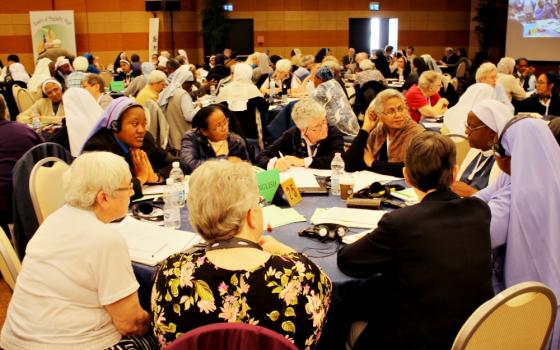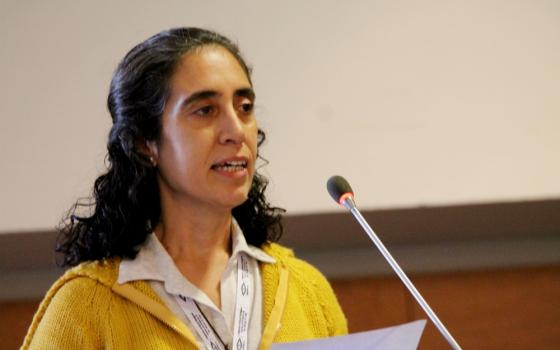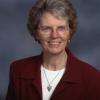Adopting a true model of interculturality is urgent for congregations and the entire Catholic Church, attendees at the International Union of Superiors General plenary assembly heard May 8.
Interculturality moves beyond a multicultural approach that recognizes differences to one that celebrates and integrates them in forging a new culture within a community, said Sr. Adriana Carla Milmanda, provincial superior for the Missionary Congregation of the Servants of the Holy Spirit of South Argentina.
In a presentation before about 850 superiors general of congregations from 80 countries, Milmanda provided a theoretical framework on moving from multiculturality to interculturality and practical approaches on how to do so. A professor of theology at the Pontificia Universidad Católica Argentina, she holds a master's degree in intercultural studies and the Bible from Catholic Theological Union in Chicago.
Many congregations were at the forefront of multicultural life for almost a century before the concept became more widespread in society, she said.
"It is this capital of experience and knowledge that we are called today to share with one another and to put at the service of humanity and the church," she said.
As congregations adapt to a more intercultural approach, women religious can by example become "one of the seeds of prophetic hope" to sow in the world, she said.
Milmanda's community sent her to Fiji to launch a new missionary presence. In the span of five years, she lived in community with sisters from Papua New Guinea, Germany, Indonesia, India and Benin.
She said this experience, which was "full of joy, discoveries, pain, misunderstandings, frustrations and much learning," motivated her to study cultures and mission.
In her presentation to UISG, she used diagrams to explain acculturation — learning and adapting to another culture — and the movement from multiculturalism to interculturality.
"Good relations, communication and good coexistence, although very important and necessary, are not enough," she said. "The intercultural community is called to take a step beyond the tolerance of differences and to live a process of transformation or conversion that challenges it to create as a result of this interrelation a new culture."
This model is "diametrically opposed" to the assimilationist model that prevailed and, in many cases, still survives in how most congregations recruited vocations in so-called "mission countries," she said. In that assimilationist model, the minority "or presumably underdeveloped, uncivilized cultures or pagans had to adapt, conform and assume the superior or majority culture while abandoning their own," Milmanda said.
By contrast, "the model presented by interculturality seeks to know, value, deepen and integrate these differences," she said. As a result, a new culture emerges "in which we can all give the best of ourselves, share our gifts and let ourselves be challenged by the encounter and the relationship with the 'different,' '' she said.
This process is countercultural, she said, one in which few people would feel comfortable because cultures "program" people to protect themselves from those who are different and their potential threats.
"Living interculturally is a vocation and a countercultural option and that, as such, appeals to the faith and to the life of grace," she said. "Humanly, we all tend to seek and interact with those with whom we feel identified and, therefore, understood."
Three elements are essential in introducing interculturality into communities, Milmanda said. The first is preparation, including basic knowledge of the traits and characteristics of the interacting cultures. Preparation also requires creation of a "safe space" where members can express themselves without fear of judgment.
The second element is intentionality, Milmanda said, which requires adopting tools for communication and resolution of expressed and latent conflicts. Work is also required on personal and community levels to strengthen the capacity for resilience and detect "the dangerous, conformist attitude that is content with a simple tolerance of the difference," she said.
Spirituality is the third element, as intercultural life "emerges from our 'catholic' (i.e., 'universal') faith" and is a lifelong personal process of conversion, she said.
"As a spiritual path, intercultural life and mission is not so much a goal, but, rather, a search and a process," she said. "There are no recipes, nor are there quick solutions to the conflicts that it entails. Rather, interculturality challenges us to live with the paradoxes and the gray zones of the liminal spaces that open us to transformation and growth."
Her message resonated with Sr. Marie Elisabeth Wirnkar, the superior general of the Sisters of the Holy Family in Cameroon, one of the attendees. She told Global Sisters Report that her community used to be solely members from Cameroon. Now, in the community of 100 sisters, there is a sister from Nigeria and five from the Democratic Republic of Congo.
Wirnkar, who is in her fifth year as congregational leader, said the sisters had little understanding of each other's cultures, and she realized the need to start encouraging sisters to appreciate and be sensitive to their differences. After the session at UISG, she said, "now, when we talk about culture, I understand better the problem and how to approach it," she said.
The assembly continues May 9 with a focus on interreligious dialogue and concludes May 10 with an audience with Pope Francis and the celebration of the 10th anniversary of the anti-trafficking network Talitha Kum.
[Gail DeGeorge is editor of Global Sisters Report. Her email address is gdegeorge@ncronline.org. Joyce Meyer is a member of the Sisters of the Presentation of the Blessed Virgin Mary and is GSR's liaison to women religious outside of the United States.]



